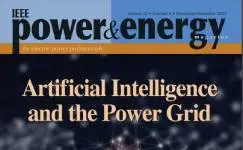-
Members: FreePES
IEEE Members: $45.00
Non-members: $70.00Pages/Slides: 54
28 Aug 2000
PREFACE This tutorial has been organized to educate practicing engineers about the latest trends in automated analysis of faults. The history on this subject dates to the late eighties when first expert systems for automated analysis were introduced. These solutions were built using early expert system implemented with programming languages such as LISP, PROLOG, and OPS. The data acquired by the Supervisory Control and Data Acquisition (SCADA) Systems was utilized for the analysis. In the last fifteen years the field has advanced with new developments being pursued in two general directions. One direction was introduction of a variety of intelligent techniques, besides expert systems, such as neural nets, fuzzy logic, genetic algorithms, object oriented programming, "etc. The other direction was the use of data from other substation recording equipment, besides SCADA Remote Terminal Units (RTUs), such as Digital Fault Recorder (DFRs), Sequence of Event Recorders (SOEs), Digital Relays (DR), etc. As a result, several practical solutions were developed and implemented at different utilities around the world. This tutorial is primarily aimed at discussing the requirements for the developments and characteristics of various systems being developed and implemented at this time. In interest of the efficiency needed in presenting a one day tutorial, the authors opted not to include discussion of the fundamental issues related to the intelligent system techniques. This material can be found in some excellent IEEE Tutorials recently presented on the subjects of Expert Systems, Neural Nets and Fuzzy Logic. The attendees of this tutorial are strongly encouraged to use the published material from the mentioned tutorials if they have a need to get acquainted with the subject of the intelligent techniques. For the completeness of the subject matter, this tutorial will also venture into discussing some of the issues of the intelligent techniques and the implementation approaches. However, the main focus of this tutorial will remain a presentation of the different options and approaches in developing and implementing automated systems for fault analysis. The first section of the report relates to the utility perspective on the subject. Mr. Larry Smith from Alabama Power has made a comprehensive sunnnary of the requirements discussing the required data, identifying the potential users of the results, reviewing possible implementation approaches, and outlining the expected benefits coming from automating the analysis. The next two sections are written by Mladen Kezunovic from Texas A&M University. These sections make a general introduction to the subjects of the equipment used for recording the data and the goals of the development. It is pointed out that the recording equipment characteristics may be quite different leading to different capability regarding the analysis implementation. It was also indicated that the final analysis goals may also be quite different depending on the end-users and hence the system implementations may have to be tailored to the specific type ofthe users. The last three sections are discussing three different approaches taken in developing some recently implemented systems for automated analysis. The different approaches are based on the use of different recording equipment and the type of the users that were to utilize the systems were diverse. Section IV describes several systems implemented using Digital Fault Recorders as the main source of data. Professor Kezunovic describes systems developed for Reliant Energy HL&P, TXU Electric, and WAPA. The basic idea incorporated in all the systems was developed by Texas A&M University, and later on was further enhanced by Texas A&M University and Test Laboratories International, Inc for the needs of the mentioned utilities. The next section describes a development that was undertaken by University of Washington under guidance of Chen-Ching Liu. The original developments were based on the use of SCADA data base, but later on were enhanced to include data from the Sequence of Events Recorders as well. Professor Liu and co-authors discuss features of a system developed jointly by EPRI and ENEL and implemented in the utility in Italy. The last sections introduces a comprehensive approach to fault analysis that utilizes data from a number of data recording devices located at various substations in the power system. The system has been developed by a group of researchers from the University of Strathclyde in Scotland, U.K., headed by Jim McDonald. In this section Professor McDonald and co-author outline the goals of the development and the implementation features ofthe new system. At the end of each section, a detailed list of references on the subject matter treated in the section is enclosed to facilitate further understanding ofthe issues discussed. Mladen Kezunovic Tutorial Editor College Station July, 2001


